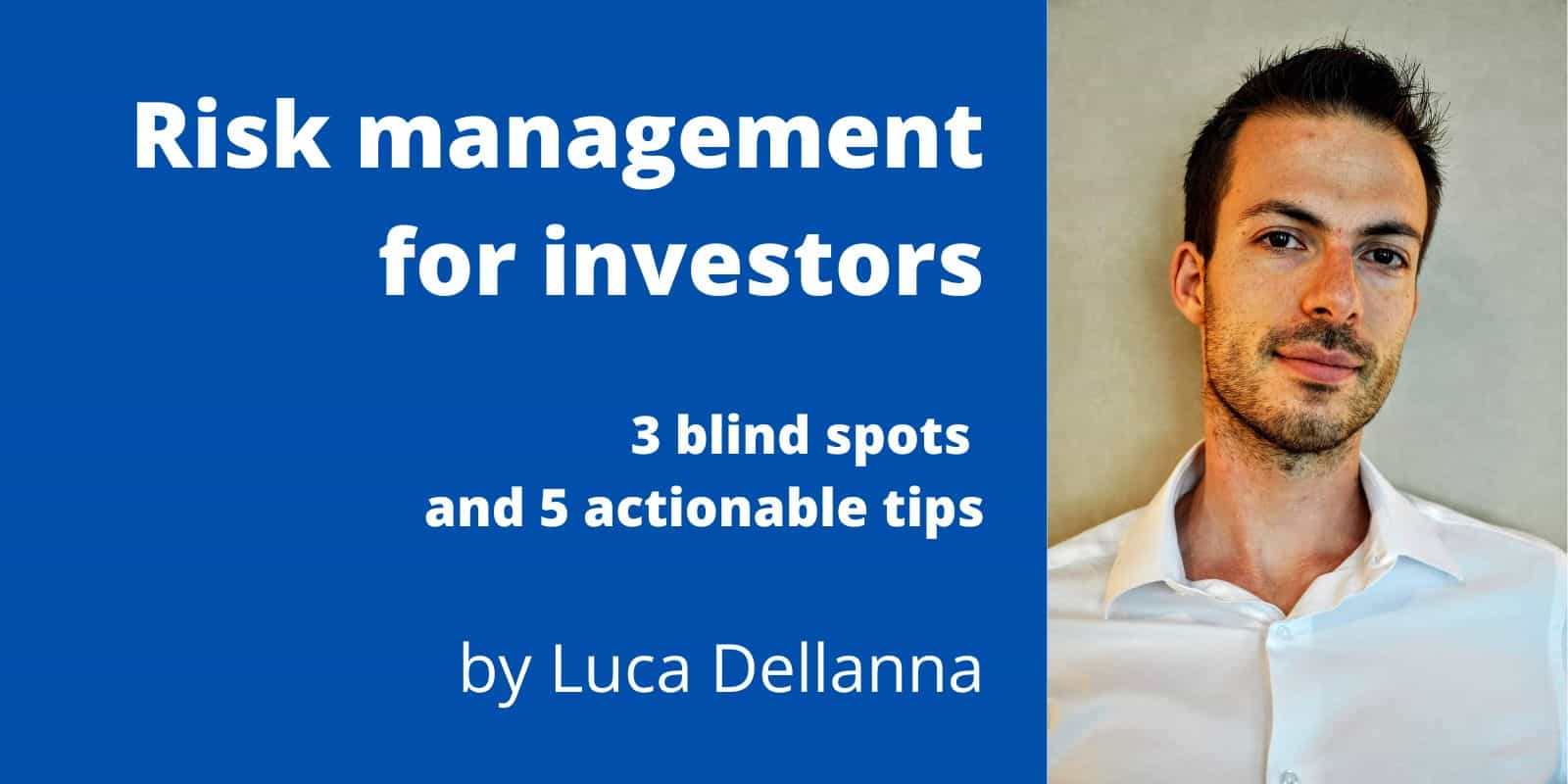The three blind spots of savvy investors when it comes to risk management and five actionable tips to address them.
Years ago, I believed that driving change within organizations required charisma and motivational speeches.
Nowadays, after having worked with many managers that repeatedly fought inertia and achieved long-lasting results, I changed my mind.
Fighting inertia mostly consists in overcoming three key obstacles:
- Doubt that efforts will be wasted. Most employees have witnessed change initiatives that created much disruption but didn’t achieve any concrete improvement. They must be convinced that this time it’s different, and words won’t cut it.
- The lack of closeness. People won’t change their ways just because their CEO asked them in a corporate-wide email. They need to see that their direct supervisor is actively committed too.
- Contradictions. People won’t change their ways if they see others still being allowed to behave the old way. This includes the manager being inconsistent with his actions and standards.
Here, I give you three catalyzers for change that overcome these obstacles and allow managers to create long-lasting change within their organizations.
The first catalyzer
Have you ever wondered why most toothpaste brands have a strong mint flavor?
Rory Sutherland pointed out that the mint flavor does nothing towards killing bacteria but does everything towards keeping you hooked on brushing teeth. Imagine if there weren’t any mint flavor. You would brush your teeth once, feel no particular change, think that your efforts went to waste, and quit the idea of brushing teeth after every meal. It’s not worth it. Conversely, if you brush your teeth once and your mouth feels fresher thanks to the mint flavor, you’re more likely to trust that brushing teeth is an effective and beneficial habit. You’d keep brushing your teeth because every day, you get immediate feedback that your efforts are not going to waste.
The same applies to organizations. People require early feedback that their efforts aren’t going to waste. As long as they get it, they stay motivated. And as soon as they don’t get it anymore, they lose motivation and disengage.
For example, if you ask your people to follow a new procedure at work, and they do it, but feel no difference, no better outcome, they will learn the lesson that their efforts are going to waste. The rational decision is to disengage and abandon doing the new thing.
Conversely, if the procedure has some kind of early feedback (like the “mint” in the toothpaste) showing that efforts are not going to waste, then people will be more willing and motivated to use the procedure and will be more engaged in general. This is the first of three catalyzers for change: give early feedback that efforts are not going to waste.
One way to implement the first catalyzer
There are three common ways to give early feedback that efforts are not going to waste. The first one is to catch your people doing something good and thank them for it. For example, if you ask your people to follow a new procedure, then spend some time at their workplace, and when you see them do the new procedure, thank them for it. It will give them a clue that their efforts are noticed and matter.
“Management hack: thank people for doing things that are a normal part of their job.” – Mark Brooks (link)
A common mistake
When I advise my clients to do the above, a common mistake is waiting too long. If you ask your people to follow a new procedure on Monday, you should already catch them doing something good on Monday. If you are waiting for Friday, by Tuesday, they will have learned the lesson that their efforts do not matter. Feedback must be early; ideally, immediate.
A second way to implement the first catalyzer
The second common way to give clues that efforts aren’t going to waste is to get positive customer feedback in front of those whose work caused it. If your product changed the life of a customer, everyone needs to know about it, from the janitor to the accountant – not just the product design team. Go get customer feedback, interview your best customers, and show the relevant bits to your employees who need to see it. And do it fast – before the doubt that efforts are going to waste creeps in.
A second common mistake
When I advise my clients to do the above, a common mistake is only getting feedback from customers. However, in a company, every employee is another employee’s customer. Everyone benefits from the janitor’s work, for example. And yet, how many give the janitor clues that his work is improving their lives? Get feedback from all departments, and show it to the workers who worked hard for them.
A third common mistake
Another common mistake is to make the above too mechanistically. For example, if you ask all your employees to make a video thanking someone else in the company, people might doubt these videos are sincere. Instead, hire a freelancer for a couple of days, give him a list of roles in your company, and ask him to find someone who benefits from each and record a 30-seconds video interviewing them. Then, distribute the videos as appropriate. Similarly, such videos shouldn’t be too sweet: just explaining why people’s work matters is sufficient. People don’t need to feel loved at their workplace, but they need to feel like their efforts aren’t going to waste. Aiming for the former will lead to a lot of insincerity and other counterproductive outcomes. Aiming for the latter is easier and more effective.
Of course, the above won’t work for all companies. But for many, it could be a turning point in the engagement of their workers.
A fourth common mistake
Some managers understand the need to give people early feedback that their efforts are not going to waste. However, they immediately start thinking about ways to provide it in a scalable way – for example, a dashboard or a monthly report. Don’t. People need personal and early feedback, whereas scalable feedback tends to be impersonal (the dashboard) or late (the monthly report).
Or, better said: you can also use dashboards and reports, but they should always be complements to personal and early feedback, not substitutes.
Summarizing the first catalyzer to change
Just like toothpaste uses the mint flavor to provide early feedback that our efforts to brush teeth aren’t going to waste, workers need early feedback that their efforts are not going to waste; otherwise, they will disengage.
Managers should constantly ask themselves, “am I providing the mint flavor?” – or, more precisely, “are my people getting early feedback that their efforts aren’t going to waste?”
It is the manager’s job to constantly provide early feedback and, where appropriate, collect personal and meaningful feedback from customers or other departments and show it to their people early enough.
Common mistakes include waiting for too long, only collecting external feedback, and making the feedback collection process too mechanical. Instead, strive for early, personal, and meaningful.
The second catalyzer
Have you ever wondered why our arteries divide into capillaries?
That’s because our blood cells can only exchange oxygen with tissue cells that are close by.
The same happens in organizations: people don’t change when asked by someone from afar. CEOs are the pumping heart of companies, but they require a capillary structure that can drive change from close by: middle management.
Yes, I know middle management gets a bad rep as an unproductive layer of the company. But that only applies to bad middle managers. Good ones are invaluable and indispensable to drive change.
Put yourself in the shoes of a line worker. You receive a corporate-wide email from the CEO saying that there is a new way of doing things. You don’t know the CEO, so you might not trust him: does he know what he’s doing? Does he have your best interests at heart? Or perhaps you trust him but do not trust that he knows how to do your job. Or you do not trust the full repercussions of the change he proposed. Long story short, workers are rationally suspicious of any change coming from someone they do not have a close working relationship with.
Instead, a direct supervisor is uniquely positioned to explain the change to his team, listen to their questions, and answer them personally. And he can do so in a way that is impossible to reproduce at scale. Moreover, as we saw with the first catalyzer, change requires early feedback that efforts are not going to waste, and that can only be given by someone close enough and trusted – reports take too long, and dashboards are too impersonal.
Change requires trust, and trust doesn’t scale, hence the need to drive change through a capillary structure made of middle and lower management.
This doesn’t mean that communication from the top is useless; contrary, it is fundamental. It just means that it is not sufficient.
How to implement the second catalyzer
There are four steps to implement the principle of driving change through a capillary structure.
First, involve middle and lower management. Cascade down the goal of driving change through supervisors, explain the rationale and clarify that supervisors need their own supervisors to drive change. Hence the need for a capillary structure (CEO → middle management → supervisors → workers) rather than a flat one (CEO → supervisors → workers).
Second, train middle and lower management. You can’t expect that your managers know how to communicate change. Train them on what to communicate and how to communicate it. Train them to listen for questions and to answer them without dismissing them. Train them on giving early feedback that efforts aren’t going to waste.
Third, explicitly demand middle and lower management to be agents of change. Be clear, and use visual examples. Describe three managers: one doing its job of driving change, one doing too little, and one doing too much – this will clarify expectations better than anything else. Set high standards: communication doesn’t happen when you can be understood but when you cannot be misunderstood, and change happens not when it is communicated but when it is followed up with consistent action.
Fourth, sustain the change initiative. Constantly demonstrate the behaviors you’re demanding in others, and keep them accountable to the high standards you asked of them. The moment you stop is the moment doubt will arise that the change you requested yesterday isn’t relevant anymore (and therefore, any further effort would go to waste).
To summarize
Change requires trust, and trust doesn’t scale – hence, the need to drive change through a capillary structure made of middle and lower management. To achieve it, involve middle and lower management, train them, and explicitly expect them to be agents of change; then, constantly sustain the change initiative by taking action demonstrating that it is still a priority. Never allow fertile ground for doubts that efforts are going to waste.
The third catalyzer
Years ago, I consulted an operations manager with a warehouse problem. At all times, employees would leave mechanical parts and components scattered on the floor – a safety hazard and an efficiency drain. And yet, no matter how many times he repeated to always store the components properly on the shelves, his workers never did.
The root problem was that the manager was too busy and the warehouse too big for him to consistently enforce the standards he asked his employees to follow.
Therefore, we decided to restrict the area of change to a single point of the warehouse, small enough so that he could consistently provide feedback on it. He chose the area next to a safety exit. He held a stand-up meeting with the warehouse employees and told them that the area next to the exit had to be clear of components at all times. He asked them to clear it immediately, and he didn’t leave the warehouse until that was done.
Then, the hard part began. For the next month, he had to visit the warehouse multiple times a day and, first thing there, look at the floor next to that safety exit to see whether it was clear. If not, he should immediately stop whatever he was doing, walk to the nearest employee, remind him that the area had to be clear, and stay there until it was.
Here is what happened.
After a week, the warehouse employees learned that the safety exit area was to be left clear.
After two weeks, the employees began noticing that the area next to the machine was easier to walk in, and parts there were easier to find.
After three weeks, the magic happened. The employees began to clear the other areas of the floor of their own account.
You see, habits require consistency, but once they’re learned, they can easily be expanded to other areas. The bottleneck was the achievement of a critical mass of consistent repetitions of the desired habit within a few weeks. However, that requires time and effort from workers and their managers alike. They’re both busy and with limited bandwidth. The solution was to shrink the area of change from the whole warehouse to the few square meters next to the safety exit, an area small enough so that busy people could focus on it frequently enough for habits to engrain.
This is the third catalyzer for change: to avoid compromising consistency, compromise in the scope of change. Don’t attempt to change too many habits and too many people at once. Instead, focus on a single habit at a time, in a single team, in a single area of their work – and then obsess over it for the next three to four weeks.
By focusing change over a small area, obsessing over it, and letting others see the benefit of the change, you will achieve what you couldn’t before. This is the magic of obsessive consistency. Once the workers understand that they can change faster than their manager, they will. Once they understand that if they change, good things happen, they will. Good managers embrace the effectiveness of obsessive consistency, and so should you.
To summarize
Change requires consistency; to achieve consistency, reduce the scope of change so that you can obsess over it for a few weeks.
Further readings
I also published two books on management, Best Practices for Operational Excellence (recently reviewed by Taylor Pearson, link) and Teams Are Adaptive Systems.
If you enjoyed this essay, you will also find my Antifragile Organizations course very valuable. If you’re interested in joining the waiting list, write me an email.


